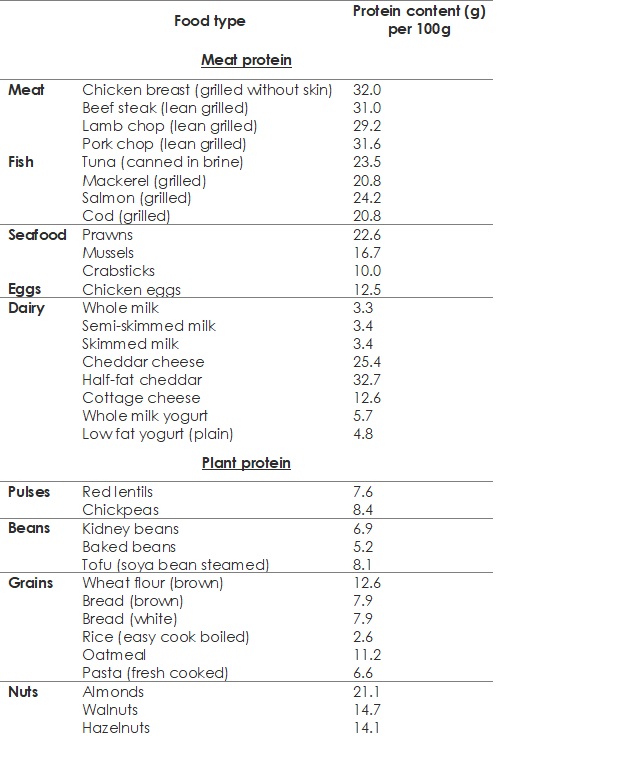Ski Instructor Training – Nutrition: Proteins
Ski Instructor Educations – Nutrition: Proteins
Proteins
Proteins have an array of crucial functions within the body, without which our bodies would not be able to function. All cells contain protein therefore it is essential for growth and repair.
Proteins such as hormones and enzymes are the ones we may be the most familiar with other functions like transport proteins (e.g. haemoglobin in the blood for transporting oxygen) whilst structural proteins like keratin and collagen are vital to our physical being as they quite literally hold us together. Approximately 43% of the proteins inside the body are muscle.
The Geeky Science Bit
All proteins are a combination of amino acids linked up in different ways for different proteins. The best way to describe them is as building blocks; the order and structure is vital to the job of the protein, just as the size and order of bricks are to buildings.
An amino acid consists of a carboxylic acid (COOH) an amine group (NH2) attached to a carbon atom, referred to as the alpha ‘α’ carbon and a variable R group the side chain of the molecule and is the radical. The properties of the radical including size, reactivity, acidity and polarity dictate how the protein is folded and functions as the properties are best utilised in its conformation.
The amino acids form together in either primary, secondary, tertiary and quaternary structures which relate to their function as proteins1. For example haemoglobin is a complex quaternary structured protein and has a complex job carrying oxygen around the body.
There are various ways of grouping amino acids but the ones we are concerned with when discussing nutrition are ‘essential’, ‘semi-essential’ and non-essential’2. It is really important to note that calling an amino acid essential or non-essential does not relate to how important it is to have in the body, but whether or not the body can produce it itself.
Amino Acids Groups
8 Essential Amino Acids.
The body can’t produce, must be consumed.
1. isoleucine
2. leucine
3. lysine
4. methionine
5. phenylalanine
6. threonine
7. tryptophan
8. valine
2 Semi-Essential Amino Acids.
The body can’t produce, must be consumed under certain circumstances.
1. arginine
2. histidine
10 Non-Essential Amino Acids.
The body can produce on its own.
1. alanine
2. asparagine
3. aspartic acid
4. cysteine
5. glutamine
6. glutamic acid
7. glycine
8. proline
9. serin
10. tyrosine
Considerations
This is the standard grouping for an average adult but the requirement changes with age. In children, arginine, histidine, cysteine, glycine, tyrosine, glutamine and proline are also considered to be essential amino acids, because children are unable to make enough to meet their needs. These are referred to as ‘conditionally’ essential. 
To understand what may happen if we do not include all of the amino acids in our diets a good example is to consider a vegan’s pet. Now protein can be animal or vegetable based and if you stop there and simply feed a cat and a dog a diet that includes an appropriate amount vegetable-based protein source, a dog would live and a cat would die. The reason is the cat is missing some of its essential amino acids taurine, retinol and arginine3. This leads to nasty health complications and death if not given meat as the body simply can’t function without them.
A cat did not evolve to eat a plant-based diet, a human decided to feed it that. And there comes one of our main issues – human choice.
Protein Stability
We have mentioned how the structure is vital to the function of a protein. However proteins can denature or fall apart and will no longer be able to perform their role.
The reasons a protein would denature is the pH of its environment, temperature and proteases (enzymes that separate the bonds that connect amino acids). Food all carry different pH values and if we overload and push our natural pH 7.4 out of balance it will start to affect the proteins that we are made from and rely upon for vital functions.
pH Negative (acidic): animal proteins, processed cereals, sugars, alcohol, coffee, sodium
pH Positive (alkaline): water, fruit, vegetables, potassium

Acid and Alkaline Forming Food
How much protein should we eat?

Considerations
As you can see, the requirements for the average adult are not significant and in fact studies show the average daily intake of protein is around 88g for men and 64g for women.
Growing infants and children, pregnant and breastfeeding women and various illnesses will dictate a change in requirement.
It has been proven that athletes do have a higher requirement for protein. Those looking to gain muscle mass frequently talk about their high protein diets, shakes etc.
Many studies have been conducted to investigate, with an explosion in the 21st century when diet and physical appearance has become a mainstream health topic.
A study showed that within four weeks of protein supplementation (3.3 versus 1.3 g·kg-1·day-1) in subjects’ resistance training, significantly greater gains were seen in protein synthesis and body mass in the group of subjects with the greater protein intake (Fern et al., 1991). So whilst it may be a little boring to listen to a Crossfitter expound the virtues of eating chicken morning, noon and night unfortunately he may have a point…but only if using it correctly.
With the excess protein the body can use it as an energy source: 1g of protein provides 16.7 kJ (4 kcal). To give a reference, 1g carbohydrate provides 16.7 kJ (4 kcal), 1g of fat provides 37.7 kJ (9 kcal).
Biological Value of Proteins
The quality of the protein is also a consideration when planning the sources in a diet. Sources from animals have a higher biological value than plant-based sources, because the patterns of the amino acids are closer related between animals and humans than plants and humans. 
Biological Value (BV): scale of measurement used to determine what percentage of a given nutrient source is utilized by the body. Measured in clinical environments.
This does not mean an adequate vegetarian or vegan diet will not provide the appropriate biological value of proteins as diets are typically made up from varied sources so as long as the person is aware of this and mixes up the sources: for example cereals, pulses and vegetables in the same meal. For example in many cultures which do not have a meat-based diet it is very common to see examples of complementary action of proteins in practice; rice and lentils is an illustration.
WHO recommends 2 – 3 servings of protein per day, with different types being consumed in order to gain all the amino acids we need for the body to function.

Return to the IASI Coach Theory page.
Ski Instructor Training – Nutrition: Proteins
References
1 – http://www.interactive-biology.com/6711/the-basics-of-protein-structure-and-function/
2 – http://www.aminoacid-studies.com/amino-acids/what-types-of-amino-acids-are-there.html
3 – http://cattime.com/cat-facts/health/10829-why-your-cat-shouldnt-go-vegan
4 – https://www.nrv.gov.au/dietary-energy
5 – http://www.who.int/topics/en/
6 – https://www.ncbi.nlm.nih.gov/pmc/articles/PMC3905294/
Ski Instructor Educations Zermatt, Switzerland. IASI Coaching Theory Course.